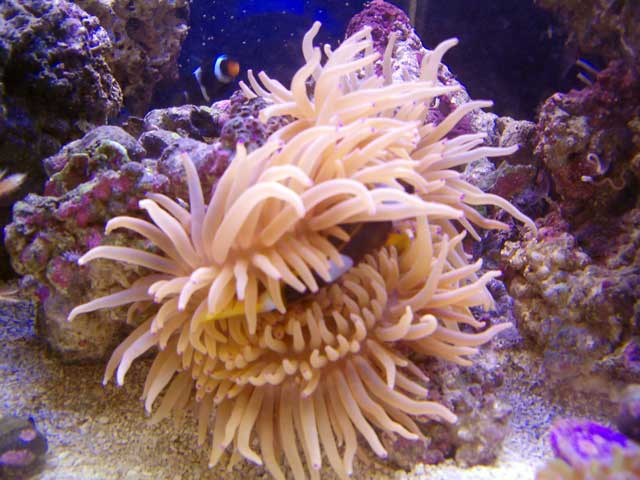
Introduction
Fish Locomotion is a field of study that looks at how fish swim. This may seem simple enough but there are many intricacies of muscle movement, fin shape, body design, habitat, prey selection, and inherent traits. By investigating how a particular fish (or group of fishes) move in their environment a hobbyist can better create environments for these animals. Click the read link to read more.

Anemonefishes are well designed to move in and out of their homes, but are not well designed for swimming far away.
Current Aspects of Aquascaping
Over the last couple of years the thoughts behind aquascaping have dramatically changed. The “rock wall†of the 80’s is fading away and aquarists are deeply involved with arches, caves, and open space. While much of this design is functional it is nearly all intended for aesthetics. This may not bother any of you, but it drives me crazy. Seeing hobbyist who want “pretty†aquarium is just a pet peeve of mine.
Thankfully some hobbyists are designing their tanks with functionality in mind. A huge shift in aquascaping has hobbyists focused on how best to design their reef for their corals. Water flow, open space, lighting, crowding, feeding, and all sorts of other terms play a role in coral growth. As a larger focus on coral growth came about, so did designs to optimize that arena.
For ideas and suggestions on aquascaping I suggest contacting aquarium design guru Scott Fellman. Scott can be reached at algaeguy01 [at[ hotmail [dot] com but don’t tell him I gave you that information 😉


Some blennies dash out for food, while others may forage in small crevices.
Future Aspects of Aquascaping
Much like the increased knowledge in coral, an increased knowledge of fishes has shifted the trends in aquascaping. Most commonly aquarists have their systems up and running well before they think of which fish to add to their little ecosystem. However, for a select few (growing in numbers) planning out the fish inhabitants is done well ahead of establishing the aquarium. In fact for some people it is done well ahead of purchasing an aquarium.

Some fish swim up and down. Others swim left and right. Some fish hang around under ledges. Others walk above. Some fish sit and wait. Others chase and pursue. Their behavior is intimately linked to their selected habitat. For this reason it is advantageous to design an aquarium with an appropriate habitat for your fishes.

Some aquariums are designed for optimal coral growth, even with coral frags along the front
Locomotion Basics
I would like to very briefly cover some of the more common locomotive styles used by reef fishes. Future articles will cover this in detail, but for now I’d like the readers to be familiar with some of general rules for fish families.

Other aquariums are designed with open swimming room for large fishes.

This aquarium is well designed for little fishes swimming in the rock work, however it does not provide much open swimming room.
Labridae
The wrasse are built for cruising. They have torpedo shaped bodies and “row†their pectoral fins. This swimming style is so popular with labrids that it has been termed labriform locomotion. These fish seem to bounce through the water and are well suited for cruising along the reef for lengthy periods of time.

Acanthuridae
The tangs are a family of horizontally compressed cruising fishes. They will school or shoal and usually swim via labriform locomotion. When “in a hurry†they will switch from using their pectoral fins and will propel themselves using their body and tail to quickly push against the water.
Scorpaenidae
Lionfishes often swim up and down. It is theorized that their large pectoral fins corral their prey, but this is disputed by many who state the pectoral fins are being used to retain balance. These fishes are very slow, and usually hunt by moving up and down in the water column. A tall aquarium may be a better choice for these fishes.


Seahorses are slow swimmers, using their dorsal fin to hover over their food (much like a helicopter) without moving their bodies.
Syngnathidae
Seahorses swim around by undulating their dorsal fin. This type of locomotion is called amiiform locomotion. Seahorses have heavy bodies and small dorsal fins. This makes them very slow swimmers. Also to swim forward a seahorse will often times “stand up†and then swim. When positioned with their ventral side down their moving fin (dorsal fin) is away from the substrate and doesn’t scare off the prey. This allows a seahorse to sit motionless and watch for food.
Pomacentridae
The damselfishes (which include anemonefishes) are known for their quick darting action and “wiggly†bodies. For short darting movements they will often times using labriform locomotion. They also employ this when “standing still†or hovering. But they also frequently use a locomotion style called Subcarangiform Locomotion. This means they undulate more than half of their body to push against the water. Often times you’ll see these fishes wiggling in an anemone. They can move forward, and backwards which is needed in their habitat. Remember, for many of these fish you can swim out of your home but you must be able to quickly get back. They don’t swim away from predators they swim into shelters.
Conclusion
First and foremost there are numerous swimming styles for reef fishes. The swimming style of any particular fish is not only dependent upon its inherent abilities but also the specific situation at any given time. While factors may (and certainly will) influence the fish’s swimming style, aquatic design and aquascaping can help create a natural situation for natural behavior. Hopefully this brief introduction will encourage hobbyists to think about the behavior of the fishes they wish to keep, before they begin designing their tanks.
Author Information
Adam Blundell M.S. is a hobbyist, lecturer, author, teacher, and research biologist. Adam is the director of the Aquatic & Terrestrial Research Team, a group which bridges the gap between hobbyists and scientists. Adam can be reached by his author forum.
References and Suggested Readings
Blundell, A., (2004) “The Basics of Fish Locomotionâ€, Advanced Aquarist Online Magazine V3 I5. USA.



